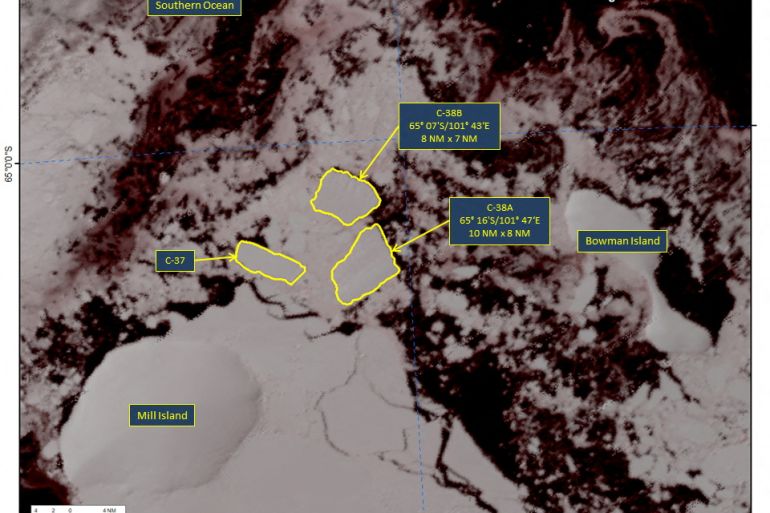Thinning Antarctica ice shelf collapses after heatwave
The Conger Ice Shelf crumbled after temperatures in the East Antarctic surged to 40C above normal earlier this month.

An East Antarctica ice shelf disintegrated this month following a period of extreme heat in the region, scientists have said.
Satellite images show the 1,200sq km (463sq miles) Conger Ice Shelf collapsed completely on or around March 15.
Keep reading
list of 4 itemsAt COP26, nations strike climate deal that falls short
New climate pledges are weak, but it is not too late to catch up
‘Climate catastrophe’: World faces 2.7C temperature rise
“Possible it hit its tipping point following the #Antarctic #AtmosphericRiver and heat wave too?” NASA Earth and Planetary Scientist Catherine Colello Walker asked on Twitter on Friday, sharing images of a white expanse crumbling into shards over the dark ocean.
Ice shelves, permanent floating sheets of ice attached to land, take thousands of years to form and act like levees holding back snow and ice that would otherwise flow into the ocean, causing seas to rise.
The March heatwave, with temperatures reaching 40C (70F) above normal in parts of East Antarctica, was tied to the atmospheric river phenomenon, said Peter Neff, a glaciologist at the University of Minnesota.
This process creates columns hundreds of kilometres long that carry water vapour from the tropics, creating an effect Neff described as “a fire hose of moisture”.
“The [Antarctic] climate is incredibly variable but this was off-scale,” Neff said. “This was at least twice as extreme of a warming event as we would have expected.”
New @usnatice-named icebergs resulting from complete collapse of East Antarctica’s Conger Ice Shelf (~1200 sq. km) on/around March 15, seen in combo of #Landsat and #MODIS imagery. #CongerIceShelf #Antarctica @helenafricker @jdmillstein https://t.co/16JtKcXQPY pic.twitter.com/lSKMNgRgNi
— Catherine Colello Walker (@CapComCatWalk) March 24, 2022
Temperatures in the region usually sit at about -51C (-60F) at this time of year, but they were about -12C (-10F) earlier this month.
They have now gone back to normal, Neff said.
Surrounded by vast oceans and buffered by winds that tend to protect it from large warm-air intrusions, the frozen continent is responding more slowly to climate change than the Arctic, which is warming at three times the rate of the rest of the world.
In the last century, East Antarctica barely warmed at all, but some regions have been affected and the continent lost an average of 149 billion tonnes of ice per year from 2002 to 2020, according to NASA. The loss of the Conger Ice Shelf is the latest example of the changes that are underway.
“This poor little ice shelf was just hanging on for dear life in this really warm coastal climate and it had been thinning and getting damaged over the last few decades,” said Neff.
The Conger shelf was splintering long before the heatwave, and its demise shows the Antarctic system is sensitive to atmospheric changes, but the event itself is not a cause for concern, said Ted Scambos, a senior research scientist at the University of Colorado Boulder.
A small glacier behind where Conger used to sit may now flow faster and unload a little more ice into the sea, he said.
“If it was in your back yard it’d be huge … but by Antarctic standards and by sea level standards, it’s a tiny area,” he said.